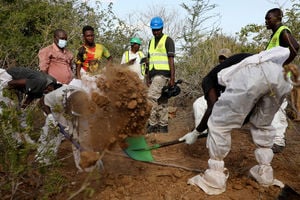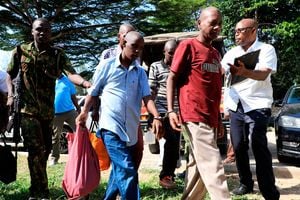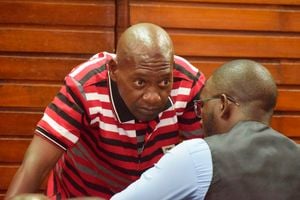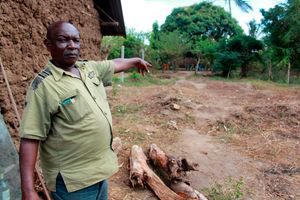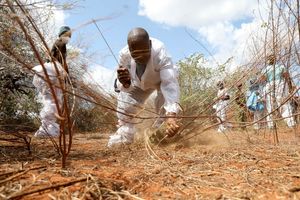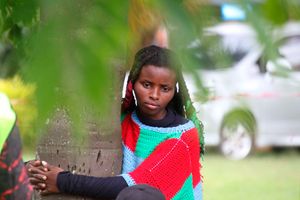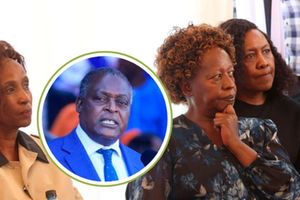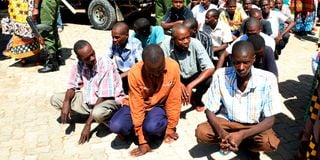
Some of the 65 suspects rescued from Shakahola Forest in Kilifi County arrive at Shanzu Magistrate's Court to face charges of attempted suicide on June 12, 2023.
In April 2023, the little-known and once-tranquil Shakahola forest, located in the heart of Kilifi County, became a theatre of horror and the setting for one of the most horrifying cult tragedies in recent Kenyan history.
At the centre of the tragedy, as the world would later discover, was the self-proclaimed pastor of the evangelical Good News International (GNI) church, Paul Nthenge Mackenzie, whose alleged morbid influence culminated in one of the deadliest cult massacres in recent times.
The state has described Mackenzie as a man whose charisma disguised a chilling derision for human life, orchestrating the deaths of over 429 worshippers, weaving religion with psychological manipulation to create an inescapable web of control.
This deadly scheme, disguised as spiritual salvation, is believed to have resulted in more than 600 believers unaccounted for and over 429, including children, dead, many succumbing to starvation as they transitioned into what they believed was the only path to meeting Jesus Christ.
Mackenzie is currently facing numerous criminal accusations in relation to the death of 429 people believed to be his believers.
They include 191 murder charges and another 238 manslaughter offenses.
In addition to manslaughter and murder charges, Mackenzie and his 94 accomplices are also facing the offence of engaging in organised criminal activity, promoting extreme belief systems for the purpose of facilitating ideologically based violence to wit fasting to death by advancing religious change, radicalisation and facilitating the commission of a terrorist act.
They are also facing several charges, including torture and cruelty against children and violation of the Basic Education Act. Mackenzie and his group are alleged to have committed all these offenses in Shakahola forest on unknown dates between January 2021 and September 2023. They had denied all these accusations.
But how did Mackenzie, as the leader of the church, manage to kill all these hundreds of worshippers, as alleged by the state?
Tight control
Witness accounts offer chilling insights into the cult’s practices and Mackenzie’s influence before and as soon as the group arrived in the forest.
Survivors who also served as witnesses described to the courts trying Mackenzie and his group how they became a community under his tight control, aided by his youthful followers.
According to the witnesses, the brainwashing of worshippers had already occurred at the church’s various branches across the country before the psychological manipulation was finalised at the church’s main branch in Furunzi.
Mackenzie had prohibited the use of modern medicine, education, and cosmetics, terming them satanic and not part of God’s plan.
“Mackenzie made us believe that we, his followers and members of the GNI, were God’s chosen people, while others were outcasts awaiting God’s wrath when the final trumpet is sounded,” a protected witness told the court during the hearing.
With all the believers refusing modern medication in times of sickness and relying solely on prayer for healing, their children withdrawn from schools and families separated from loved ones questioning their beliefs, it was announced that all believers were to move into the wilderness, away from the government's eye and reach, where they would settle briefly before rapture (Kunyakuliwa).
The vast forest was carefully divided into "biblical villages," each named after sacred sites like Bethlehem, Nazareth, and Judah to aid in the administration of his followers, who, according to records, numbered over 700.
The state indicated that this symbolic naming served a dual purpose: reinforcing the spiritual significance of the area and fostering a sense of divine destiny among Mackenzie’s followers.
To the indoctrinated faithful, they were not in a Kenyan forest but in a sacred realm where they awaited the imminent rapture, often referred to as Kunyakuliwa by the doomsday preacher.
The eight cities were Galilee, Judea, Bethlehem, Jerusalem, Emmaus, Sidonia, Tiru, and Sikare. Every follower of Mackenzie was allocated land and settled in these villages as soon as they arrived in the forest.
Each city was managed by members who formed a "close cabinet" of trusted Mackenzie followers, including Smart Deri Mwakalama and Evans Kolombe Sirya. Mackenzie monitored everything from his Judea residence. This is where he also held his meetings on Saturdays under a tree.
Witnesses, particularly minors, referred to some of these Mackenzie men by the names of the cities they administered during court proceedings.
These cities, as the court was informed, played a crucial role when a total fast was declared in the forest around January of last year.
Mackenzie’s followers were forbidden from venturing beyond their assigned areas, a rule enforced by youthful enforcers who acted as Mackenzie’s de facto guards.
This cadre of loyalists patrolled the forest, ensuring that no one escaped or defied the strict orders to fast. Survivors recounted how dissent was met with swift punishment, often physical, to suppress the rebellion and maintain Mackenzie’s iron grip.
A lorry belonging to Mackenzie and driven by Mzee Smart transported believers to Shakahola. It bore the inscriptions “Kisha Nikaona” and “Times TV The Final Trumpet.”
“The rule was that you stay in the tent temporarily for a day, then you move to your own house the next day. We used black polythene paper to construct a temporary house on the land that my mother had purchased. We were settled at Galilee,” a minor told the court.
There was no movement outside of these villages unless permitted by Mackenzie, but leaving was prohibited when total fast was declared in January 2023.
“Mackenzie recruited men whose role was to prevent anyone from escaping the forest and to block outsiders from trespassing into his territory,” a 17-year-old witness told Chief Magistrate Alex Ithuku during the hearing of the case.
Witnesses informed the court that those who attempted to escape the pangs of hunger were intercepted, beaten, tied up and encouraged to complete the fast.
Massacre
Another witness who was among the first responders when the massacre was discovered said Mackenzie’s men assaulted him for attempting to rescue their wives from starvation in the forest.
These men were armed with bows, machetes, and arrows.
The witness, identified as ROC, stated that the men also accused him of taking their wives to Babel (outside the forest) and began to assault him.
“I was beaten with the blunt edges of pangas, struck with rungus, and kicked. They took me into the bush and forced me to board a motorbike,” he said while being questioned by Mackenzie’s lawyer, Lawrence Obonyo.
The irate men then took the witness to a dense bush where they debated whether to burn him or take him to the police station.
Evidence presented in court shows that these men tied their victims with ropes while still alive during the enforcement of the lethal fast and even inside their graves where they were ultimately interred after taking their last breaths.
Video footage played in court during the hearing showed the bodies wrapped in white sheets, with the leg and neck areas bound with ropes. Others were wrapped in blankets and green polythene bags.
“During the search and rescue mission, some victims who had been confined in various houses were found naked, with their legs bound together using headscarves to prevent them from escaping or seeking help,” said Police Constable Bernard Jefwa.
This evidence lends credence to an initial report indicating that there were torture chambers within the forest, where pieces of cloth and ropes, along with several other unidentified items, were recovered during the operation in the forest.
While others were dying from starvation, the men standing guard were enjoying a good meal. Witnesses mostly found them relishing a dish of rice and lablab on their plates.
Evidence from witness testimony suggests that Mackenzie not only employed psychological manipulation to control his followers but also used threats, intimidation, and false hope to force them into spiritual submission.
“Mackenzie made it clear to us that a child who died after his own children would not enter heaven, prompting every believer to ensure their children died quickly before those of their preacher,” the minor said. Parents thereafter ensured their children starved to death as soon as possible.
Some of these parents told the court how they were forced to starve their children to death.
The court heard that the believers were told that death by starvation was the only sure way to meet Jesus and escape an undisclosed calamity that was to consume the world by June 2023, so every believer and their children were to be dead before that tragedy.
“Mackenzie came to us and told us that he had been sent by Jesus to declare the start of the fasting, beginning with the children before he could finalise the fast with his family. We were instructed to start express fasting with no bathing or drinking of water,” the witness said.
To encourage more believers to die, the court heard Mackenzie praised those who were dying as heroes and urged many to continue fasting and dying because the end times had come.
The burials of the dying faithful were reportedly referred to as Harusi (wedding), and the deceased were called Shujaas (heroes).
“Mackenzie told us we would suffer for the last time, for there would be no more suffering in heaven, our final destination,” said a witness.
As the police began arriving in the forest with families searching for their loved ones, the witnesses stated they would move from one location to another deep within the forest to evade capture by the police.
Calamity
Mackenzie’s followers had motorbikes that were used to transport the believers from their homes to makeshift tents deep in the forest. The prosecution and its witness indicated that many believers, including minors, perished during these movements.
A 52-year-old senior pastor who served under Mackenzie revealed that the misinterpretation of the Book of Revelation, coupled with the outbreak of Covid-19, helped the doomsday preacher instil fear among his followers and positioned himself as a prophet of a calamity that came to pass.
“It made the end time’s messages relevant to the believers and fostered an environment conducive to seclusion in the forest. Mackenzie’s assurance that their needs would be met by divine providence, as they would be fed by Manna from Christ, motivated the believers to move into the forest,” said the pastor.
Central to Mackenzie’s teachings, as submitted in court, was the belief that fasting to the point of death was the ultimate act of faith. The doomsday preacher convinced his congregation that their earthly lives were tainted by sin and that starvation was the only path to spiritual purity and eternal glory.

